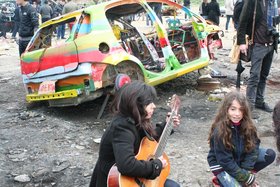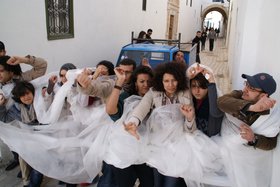Essays
Revolution and Cultural Mutation
Today in Tunisia and Egypt, and perhaps soon in other oppressed countries, reality exceeds the wildest dreams of emancipation. For decades, anti-democratic practices forbidding freedom of speech and the use of public spaces led to a withdrawn attitude which often steered artistic creations toward the sphere of intimacy – partly to avoid political censorship. This position was also a subtle way to question the modes of identification and subjectivation of the marginalized citizen. Among the best-known works adopting such a stance, one can quote films such as Nouri Bouzid's L'homme de cendres andMoufida Tlatli's La saison des hommes, Alaa Al Aswany's novel L'immeuble Yacoubian or else Jalila Baccar and Fadhel Jaibi's play Jounoun.
More recently, multi-media installations, video works and performances – usually by female artists dealing with womanhood and its social and cultural implications – have deliberately taken an existentialist approach when tackling difference and exclusion. These fictional apparatuses have, at different levels and more or less subversively, re-appropriated the real in order to highlight the various forms that domination and alienation can take. Featuring linguistic, visual and sonic media, these works question the fake normality of the politico-cultural system. Alternative music bands, rappers and one-man-show performers, subtly dealing with multifarious forms of repression and alienation, have captured the imagination of young people looking for ways to express themselves. The continuous rejections experienced by the artists as well as their frustration at the ministry's biased cultural policy have generated a genuine force of resistance and a desire to get rid of this incapacitating system. One must note that the censorship exerted on the media, filmic and literary production has ended up creating a sort of self-censorship that has resulted in fewer and fewer interesting productions.
What happened in Tunisia and in Egypt during the last few months has shown how much new media has been able to actualize the present and to anticipate events – and how much these fictional apparatuses have become catalysts for action. Tunisian and Egyptian peoples' fights for freedom and dignity have been called youth revolution and cyber revolution; these revolutions have also arisen through the image and its powers. It is clear that the use of the web has allowed the emergence of new forms of images that are altogether informational, fictional and creative. Combining speed, visibility, movement and content, these systems have generated in real time a communicative and infectious intensity. Facebookers have exploited the power of the images they produced or reproduced by bypassing the various forms of censorship and widely circulating photos of upheavals and acts of repression – not just as the mirror of a reality, but as a representation of the reality to come. These snapshots, often captured in dangerous situations with video cameras, cameras or mobile phones, have functioned like rallying cries – and thus have become participatory apparatuses allowing interactivity and shared creation through a system of transmission. Web-users' imaginative strength has contributed to undoing the icons of power and to submitting them to various misappropriations in order to exorcize the monster. These new approaches are part of a resistance through new forms of individuation from creative and desiring social subjectivities. Interactive and creative actions have revealed how perversely our perceptions are managed. They place us beyond a univocal conception of art and open up a field of possibilities allowing difference and plurality.
In free Tunisia today, artists have chosen to manifest their new reality with installations and musical performances, as well as with other actions in public spaces. They respond to the radically new socio-political situation we are currently living in and materialize the ongoing revolution's space and time. These artists' strategies allow interactions that call for the civic participation of the spectators/actors and recreate social links in the neighbourhoods' micro-societies. One must notice that the strength of these new 'real-fictions' lies in the fact that these initiatives do not simply accompany events but also contribute to them. This is true in the visual arts where the pictorial transcends itself in the materiality of the revolutionary object, like for example, in Tunis, in the works of artist Amel Zaïem, which combine painting with bits of burnt wood evoking the shape of a guillotine, representing the future of all dictatorship. But the performances and interventions in public space are no doubt what most spontaneously respond to the current circumstances. Besides the various graffiti and tags sprayed on the facades of official buildings and on the walls of the occupied Kasbah, these actions are what best encapsulate today's new social situations and new ways of living one's civic commitment. Sana Tamzini and Sonia Kallel's happenings in the street have artistically expressed a hymn to freedom, which they associate with values such as the respect of the other. They have worked with young design students, putting together performances with their makeshift barricades that enacted the creation of neighbourhood associations (HORR 1, Place Bir Lahjar, 19 February 2011). Another, equally efficient strategy has generated an interesting local dynamic in the area of Carthage Byrsa in Tunis, on a wasteland that had become a dumping ground for burnt cars during the insurrections. On 27 February 2011, these angry ruins were pictorially revisited, tagged and transformed by artist Faten Rouissi and several art and architecture students, as well as by local people. Artistic strategies favouring relational aesthetics to pure contemplation respond to a new field of sensitivities and the way it can be circulated. They are becoming more and more frequent throughout the Tunisian territory and manifest the active presence of social subjectivities - the ones of artist-citizens, fully immersed in a new reality where everything is possible.







